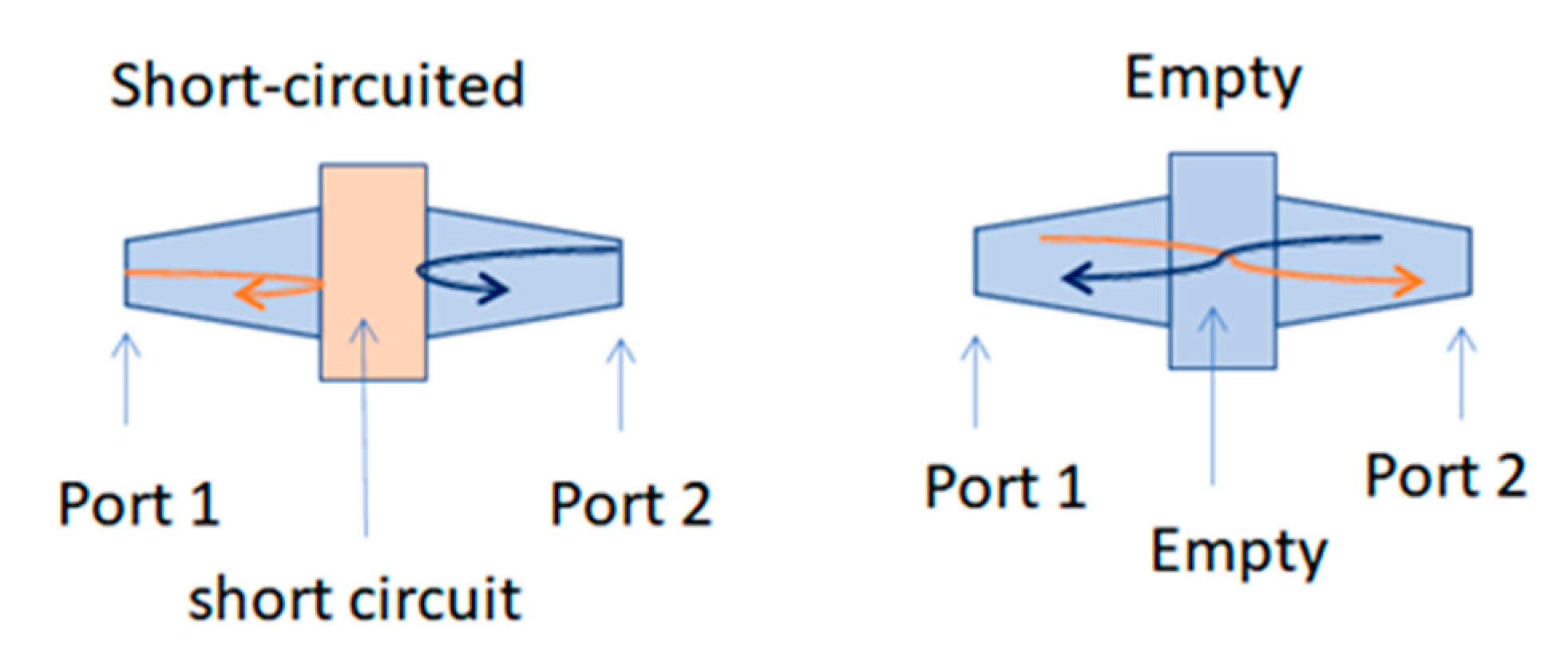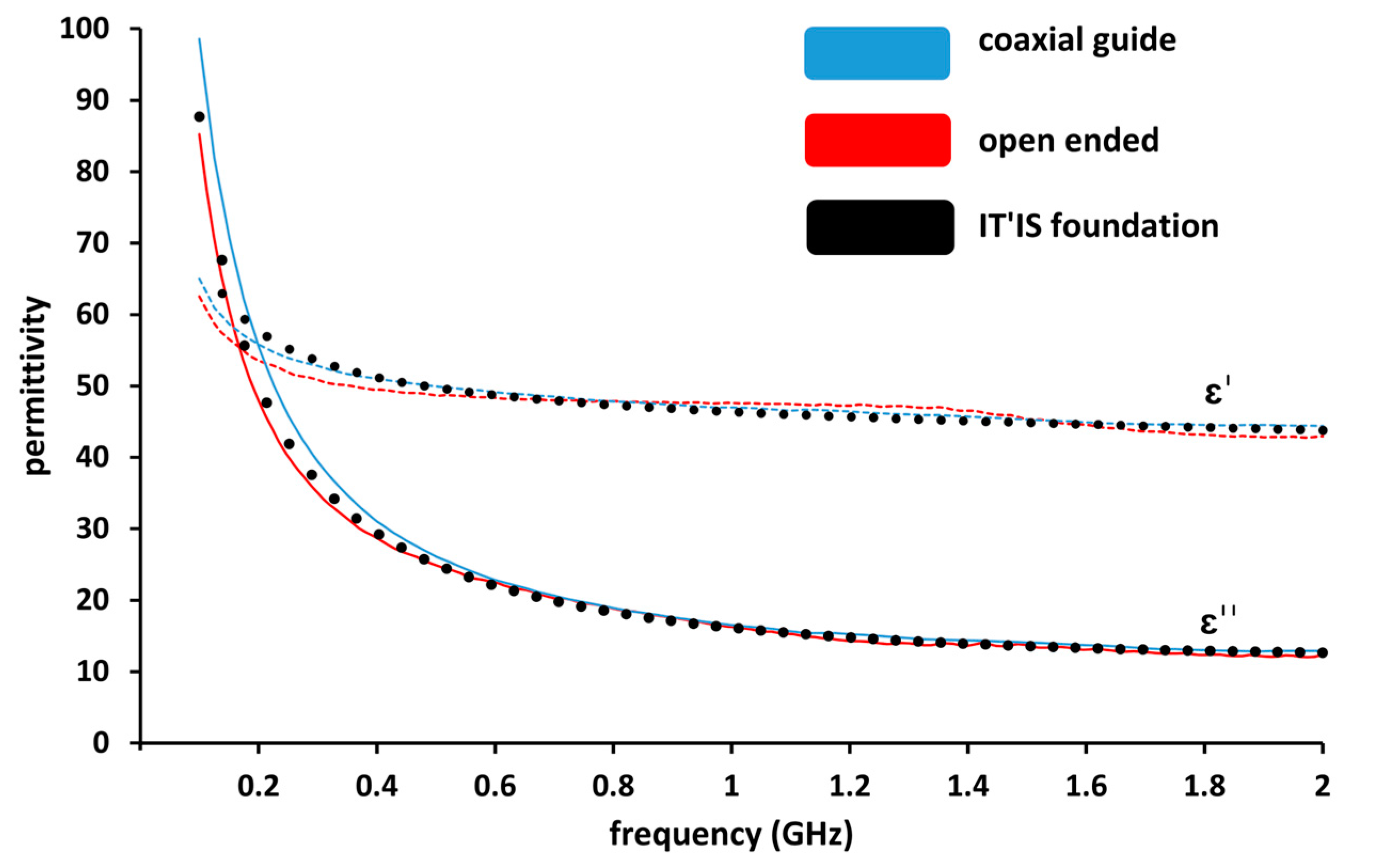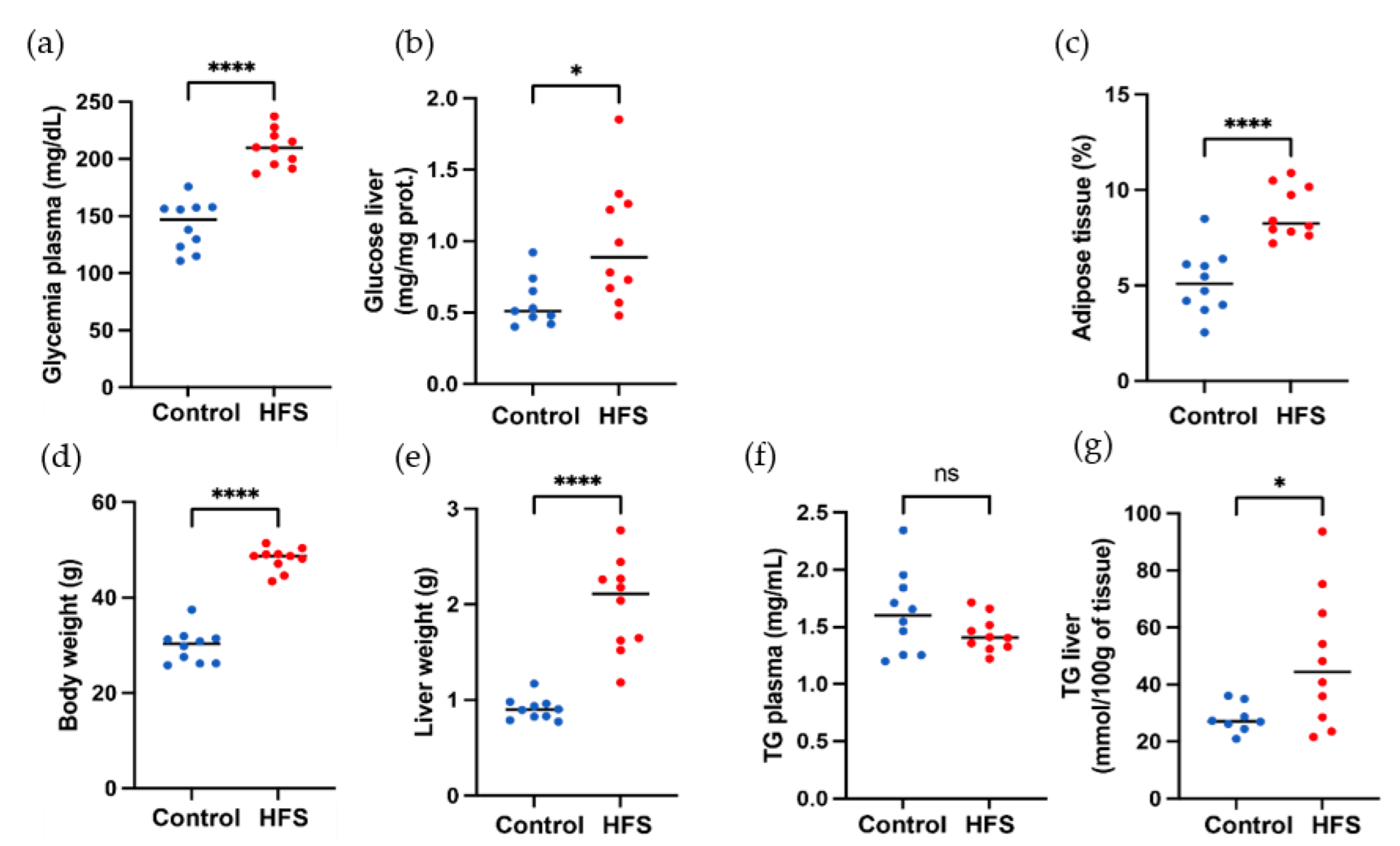Dielectric and Biological Characterization of Liver Tissue in a High-Fat Diet Mouse Model
Abstract
:1. Introduction
2. Materials and Methods
2.1. Animals, Diets, and Protocol
2.2. Biochemical Analysis
2.3. Dielectric Analysis
- S11 port 1 emitter and port 1 receiver (reflection coefficient)
- S21 port 1 emitter and port 2 receiver (transmission coefficient)
- S12 port 2 emitter and port 1 receiver (transmission coefficient)
- S22 port 2 emitter and port 2 receiver (reflection coefficient)
- (j,j) ∈ [1;2]
- k: wave vector
- L: length sample size
- ω: Angular frequency
- s: sample
- m: measurement
- sc: short-circuit
- em: empty
2.4. Statistical Analysis
3. Results
4. Discussion
5. Conclusions
Author Contributions
Funding
Institutional Review Board Statement
Informed Consent Statement
Conflicts of Interest
References
- Truong, B.C.Q.; Tuan, H.D.; Fitzgerald, A.J.; Wallace, V.P.; Nguyen, H.T. A Dielectric Model of Human Breast Tissue in Terahertz Regime. IEEE Trans. Biomed. Eng. 2015, 62, 699–707. [Google Scholar] [CrossRef]
- Gun, L.; Ning, D.; Liang, Z. Effective Permittivity of Biological Tissue: Comparison of Theoretical Model and Experiment. Math. Probl. Engineering 2017, 2017, 7249672. [Google Scholar] [CrossRef] [Green Version]
- Athey, T.W.; Stuchly, M.A.; Stuchly, S.S. Dielectric Properties of Biological Substances at Radio Frequencies. Part I-Measurement Method. IEEE Trans. Microw. Theory Tech. 1982, 30, 82–86. [Google Scholar] [CrossRef] [Green Version]
- Izzo, F.; Granata, V.; Grassi, R.; Fusco, R.; Palaia, R.; Delrio, P.; Carrafiello, G.; Azoulay, D.; Petrillo, A.; Curley, S.A. Radiofrequency Ablation and Microwave Ablation in Liver Tumors: An Update. Oncologist 2019, 24, e990–e1005. [Google Scholar] [CrossRef] [PubMed] [Green Version]
- D’Andrea, J.A. Behavioral Evaluation of Microwave Irradiation. Bioelectromagnetics 1999, 20, 64–74. [Google Scholar] [CrossRef]
- Gabriel, S.; Lau, R.W.; Gabriel, C. The Dielectric Properties of Biological Tissues: II. Measurements in the Frequency Range 10 Hz to 20 GHz. Phys. Med. Biol. 1996, 41, 2251–2269. [Google Scholar] [CrossRef] [Green Version]
- Salman, S.; Psychoudakis, D.; Volakis, J.L. Determining the Relative Permittivity of Deep Embedded Biological Tissues. IEEE Antennas Wirel. Propag. Lett. 2012, 11, 1694–1697. [Google Scholar] [CrossRef]
- Fahmy, H.M.; Hamad, A.M.; Sayed, F.A.; Abdelaziz, Y.S.; Abu Serea, E.S.; Mustafa, A.B.E.-D.; Mohammed, M.A.; Saadeldin, A.M. Dielectric Spectroscopy Signature for Cancer Diagnosis: A Review. Microw. Opt. Technol. Lett. 2020, 62, 3739–3753. [Google Scholar] [CrossRef]
- Kuhn, M.J.; Awida, M.; Mahfouz, M.R.; Fathy, A.E. Open-Ended Coaxial Probe Measurements for Breast Cancer Detection. In Proceedings of the 2010 IEEE Radio and Wireless Symposium (RWS), New Orleans, LA, USA, 10–14 January 2010; pp. 512–515. [Google Scholar]
- Mobashsher, A.T.; Mahmoud, A.; Abbosh, A.M. Portable Wideband Microwave Imaging System for Intracranial Hemorrhage Detection Using Improved Back-Projection Algorithm with Model of Effective Head Permittivity. Sci. Rep. 2016, 6, 20459. [Google Scholar] [CrossRef] [Green Version]
- Yilmaz, T.; Foster, R.; Hao, Y. Radio-Frequency and Microwave Techniques for Non-Invasive Measurement of Blood Glucose Levels. Diagnostics 2019, 9, 6. [Google Scholar] [CrossRef] [Green Version]
- Hanna, J.; Bteich, M.; Tawk, Y.; Ramadan, A.H.; Dia, B.; Asadallah, F.A.; Eid, A.; Kanj, R.; Costantine, J.; Eid, A.A. Noninvasive, Wearable, and Tunable Electromagnetic Multisensing System for Continuous Glucose Monitoring, Mimicking Vasculature Anatomy. Sci. Adv. 2020, 6, eaba5320. [Google Scholar] [CrossRef] [PubMed]
- Bakkali, A.; Buisson, C.; Mounien, L.; Landrier, J.; Tishkova, V.; Sabouroux, P. First Microwave Tomography Approach Towards a Truly Noninvasive, Pain-Free and Wearable Blood Glucose Monitoring Device. Prog. Electromagn. Res. M 2021, 102, 193–206. [Google Scholar]
- Nassir, F.; Rector, R.S.; Hammoud, G.M.; Ibdah, J.A. Pathogenesis and Prevention of Hepatic Steatosis. Gastroenterol. Hepatol. 2015, 11, 167–175. [Google Scholar]
- World Gastroenterology Organisation (WGO). Available online: https://www.worldgastroenterology.org (accessed on 2 November 2022).
- Rezaeieh, S.A.; Brankovic, A.; Janani, A.S.; Mohammed, B.; Darvazehban, A.; Zamani, A.; Macdonald, G.A.; Abbosh, A.M. Wearable Electromagnetic Belt for Steatotic Liver Detection Using Multivariate Energy Statistics. IEEE Access 2020, 8, 201847–201860. [Google Scholar] [CrossRef]
- Janani, A.S.; Ahdi Rezaeieh, S.; Darvazehban, A.; Khosravi-Farsani, M.; Keating, S.E.; Abbosh, A.M. Electromagnetic Method for Steatotic Liver Detection Using Contrast in Effective Dispersive Permittivity. IEEE J. Electromagn. RF Microw. Med. Biol. 2022, 6, 331–339. [Google Scholar] [CrossRef]
- Janani, A.; Rezaeieh, S.; Darvazehban, A.; Zamani, A.; Brankovic, A.; Mohammed, B.; Macdonald, G.; Abbosh, A. Hepatic Steatosis Detection Using Differential Effective Permittivity. IEEE Trans. Antennas Propag. 2021, 69, 8842–8853. [Google Scholar] [CrossRef]
- Peyman, A.; Kos, B.; Djokić, M.; Trotovšek, B.; Limbaeck-Stokin, C.; Serša, G.; Miklavčič, D. Variation in Dielectric Properties Due to Pathological Changes in Human Liver: Dielectric Properties of Liver Tumors. Bioelectromagnetics 2015, 36, 603–612. [Google Scholar] [CrossRef]
- Di Meo, S.; Bonello, J.; Farhat, I.; Farrugia, L.; Pasian, M.; Camilleri Podesta, M.T.; Suleiman, S.; Calleja-Agius, J.; Sammut, C.V. The Variability of Dielectric Permittivity of Biological Tissues with Water Content. J. Electromagn. Waves Appl. 2022, 36, 48–68. [Google Scholar] [CrossRef]
- Shahzad, A.; Elahi, A.; Donlon, P.; O’Halloran, M. A Water Dependent Tissue Dielectric Model for Estimation of In-Vivo Dielectric Properties. In Proceedings of the 2020 IEEE MTT-S International Microwave Biomedical Conference (IMBioC), Toulouse, France, 14–17 December 2020; pp. 1–3. [Google Scholar]
- Shahzad, A.; Khan, S.; Jones, M.; Dwyer, R.M.; O’Halloran, M. Investigation of the Effect of Dehydration on Tissue Dielectric Properties in Ex Vivo Measurements. Biomed. Phys. Eng. Express 2017, 3, 045001. [Google Scholar] [CrossRef] [Green Version]
- Mašek, T.; Filipović, N.; Vuica, A.; Starčević, K. Effects of Treatment with Sucrose in Drinking Water on Liver Histology, Lipogenesis and Lipogenic Gene Expression in Rats Fed High-Fiber Diet. Prostaglandins Leukot. Essent. Fat. Acids 2017, 116, 1–8. [Google Scholar] [CrossRef]
- Sumiyoshi, M.; Sakanaka, M.; Kimura, Y. Chronic Intake of High-Fat and High-Sucrose Diets Differentially Affects Glucose Intolerance in Mice. J. Nutr. 2006, 136, 582–587. [Google Scholar] [CrossRef] [PubMed] [Green Version]
- Torres-Villalobos, G.; Hamdan-Pérez, N.; Tovar, A.R.; Ordaz-Nava, G.; Martínez-Benítez, B.; Torre-Villalvazo, I.; Morán-Ramos, S.; Díaz-Villaseñor, A.; Noriega, L.G.; Hiriart, M. Combined High-Fat Diet and Sustained High Sucrose Consumption Promotes NAFLD in a Murine Model. Ann. Hepatol. 2015, 14, 540–546. [Google Scholar] [CrossRef] [PubMed]
- Lima, M.L.R.; Leite, L.H.; Gioda, C.R.; Leme, F.O.; Couto, C.A.; Coimbra, C.C.; Leite, V.H.; Ferrari, T.C.A. A Novel Wistar Rat Model of Obesity-Related Nonalcoholic Fatty Liver Disease Induced by Sucrose-Rich Diet. J. Diabetes Res. 2016, 2016, 9127076. [Google Scholar] [CrossRef] [PubMed] [Green Version]
- Sánchez-Lozada, L.G.; Mu, W.; Roncal, C.; Sautin, Y.Y.; Abdelmalek, M.; Reungjui, S.; Le, M.; Nakagawa, T.; Lan, H.Y.; Yu, X. Comparison of Free Fructose and Glucose to Sucrose in the Ability to Cause Fatty Liver. Eur. J. Nutr. 2010, 49, 1–9. [Google Scholar] [CrossRef] [Green Version]
- Martellosio, A.; Bellomi, M.; Pasian, M.; Bozzi, M.; Perregrini, L.; Mazzanti, A.; Svelto, F.; Summers, P.E.; Renne, G.; Preda, L. Dielectric Properties Characterization From 0.5 to 50 GHz of Breast Cancer Tissues. IEEE Trans. Microwave Theory Techn. 2017, 65, 998–1011. [Google Scholar] [CrossRef]
- Karacolak, T.; Moreland, E.C.; Topsakal, E. Cole-Cole Model for Glucose-Dependent Dielectric Properties of Blood Plasma for Continuous Glucose Monitoring. Microw. Opt. Technol. Lett. 2013, 55, 1160–1164. [Google Scholar] [CrossRef]
- Georget, É.; Abdeddaim, R.; Sabouroux, P. A Quasi-Universal Method to Measure the Electromagnetic Characteristics of Usual Materials in the Microwave Range. Comptes Rendus Phys. 2014, 15, 448–457. [Google Scholar] [CrossRef]
- Georget, E.; Diaby, F.; Abdeddaim, R.; Sabouroux, P. Permittivity Measurement of Materials of Different Natures. In Proceedings of the The 8th European Conference on Antennas and Propagation (EuCAP 2014), The Hague, The Netherlands, 6–11 April 2014; pp. 1085–1088. [Google Scholar]
- Ba, D.S. Optimisation d’une Procédure de Caractérisation Électromagnétique de Matériaux Dans Le Domaine Des Micro-Ondes: Application Aux Milieux Granulaires Secs et Humides. Ph.D. Thesis, Aix-Marseille University, Marseille, France, 2010. [Google Scholar]
- Sabouroux, P. Modélisation et Caractérisation de Matériaux Absorbants Dans Le Domaine Des Hyperfréquences. Ph.D. Thesis, University of Bordeaux, Bordeaux, France, 1992. [Google Scholar]
- Nicolson, A.M.; Ross, G.F. Measurement of the Intrinsic Properties of Materials by Time-Domain Techniques. IEEE Trans. Instrum. Meas. 1970, 19, 377–382. [Google Scholar] [CrossRef] [Green Version]
- Tissue Frequency Chart IT’IS Foundation. Available online: https://itis.swiss/virtual-population/tissue-properties/database/tissue-frequency-chart/ (accessed on 10 February 2023).
- Farrugia, L.; Wismayer, P.S.; Mangion, L.Z.; Sammut, C.V. Accurate in Vivo Dielectric Properties of Liver from 500 MHz to 40 GHz and Their Correlation to Ex Vivo Measurements. Electromagn. Biol. Med. 2016, 35, 365–373. [Google Scholar] [CrossRef]
- Yilmaz, T. Multiclass Classification of Hepatic Anomalies with Dielectric Properties: From Phantom Materials to Rat Hepatic Tissues. Sensors 2020, 20, 530. [Google Scholar] [CrossRef] [PubMed] [Green Version]







| Reference | Type of Measurement | Species | Liver Tissue | Frequency Range | Real Permittivity (1 GHz) |
|---|---|---|---|---|---|
| Peyman and all 2015 [19] | ex-vivo (1 h max) | human | Healthy | 200 MHz–5 GHz | 46 |
| Tumor | 42 | ||||
| Steatosis | 44 | ||||
| Farrugia and all 2016 [36] | in-vivo | rat | Healthy | 500 MHz–40 GHz | 49 |
| ex-vivo (1 min) | 52 | ||||
| ex-vivo (6 min) | 49 | ||||
| Shahzad and all 2017 [22] | ex-vivo (8 ± 3 min) | bovine | Healthy | 500 MHz–20 GHz | 48 |
| Yilmaz 2020 [37] | in-vivo | rat | Healthy | 500 MHz–6 GHz | 47 |
| Malignant | 55 | ||||
| cirrhosis | 53 | ||||
| Shahzad et al., 2020 [21] | ex-vivo | bovine | Healthy | 500 MHz–8.5 GHz | 49 |
| Di Meo et al., 2021 [20] | ex-vivo | porcine | 0.5 GHz–50 GHz | 50 | |
| ovine | 48 | ||||
| bovine | 46 | ||||
| human cadaver | 52 | ||||
| Present study | ex-vivo (3–6 min) | mouse | Healthy | 100 MHz–2 GHz | 42 ± σ = 2 |
| HFS diet | 31 ± σ = 3 σ: deviation |
Disclaimer/Publisher’s Note: The statements, opinions and data contained in all publications are solely those of the individual author(s) and contributor(s) and not of MDPI and/or the editor(s). MDPI and/or the editor(s) disclaim responsibility for any injury to people or property resulting from any ideas, methods, instructions or products referred to in the content. |
© 2023 by the authors. Licensee MDPI, Basel, Switzerland. This article is an open access article distributed under the terms and conditions of the Creative Commons Attribution (CC BY) license (https://creativecommons.org/licenses/by/4.0/).
Share and Cite
Buisson, C.; Mounien, L.; Sicard, F.; Landrier, J.-F.; Tishkova, V.; Sabouroux, P. Dielectric and Biological Characterization of Liver Tissue in a High-Fat Diet Mouse Model. Sensors 2023, 23, 3434. https://doi.org/10.3390/s23073434
Buisson C, Mounien L, Sicard F, Landrier J-F, Tishkova V, Sabouroux P. Dielectric and Biological Characterization of Liver Tissue in a High-Fat Diet Mouse Model. Sensors. 2023; 23(7):3434. https://doi.org/10.3390/s23073434
Chicago/Turabian StyleBuisson, Clément, Lourdes Mounien, Flavie Sicard, Jean-François Landrier, Victoria Tishkova, and Pierre Sabouroux. 2023. "Dielectric and Biological Characterization of Liver Tissue in a High-Fat Diet Mouse Model" Sensors 23, no. 7: 3434. https://doi.org/10.3390/s23073434





